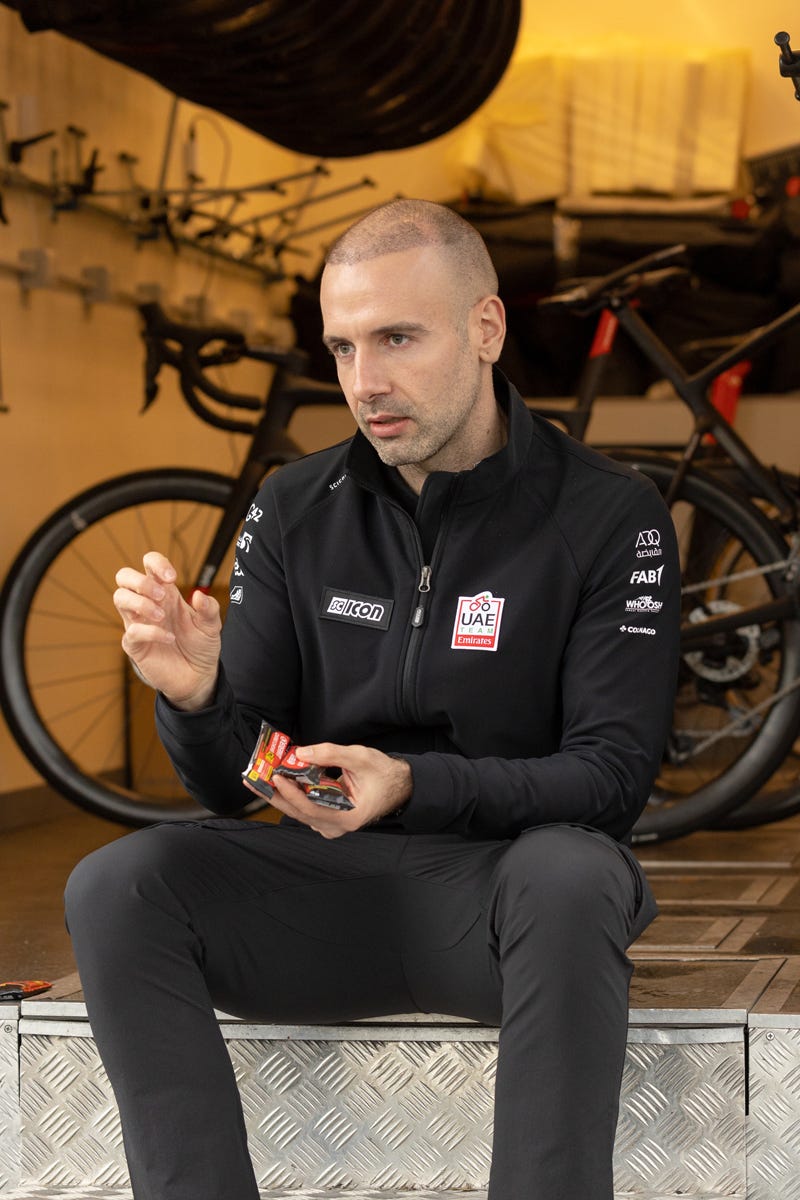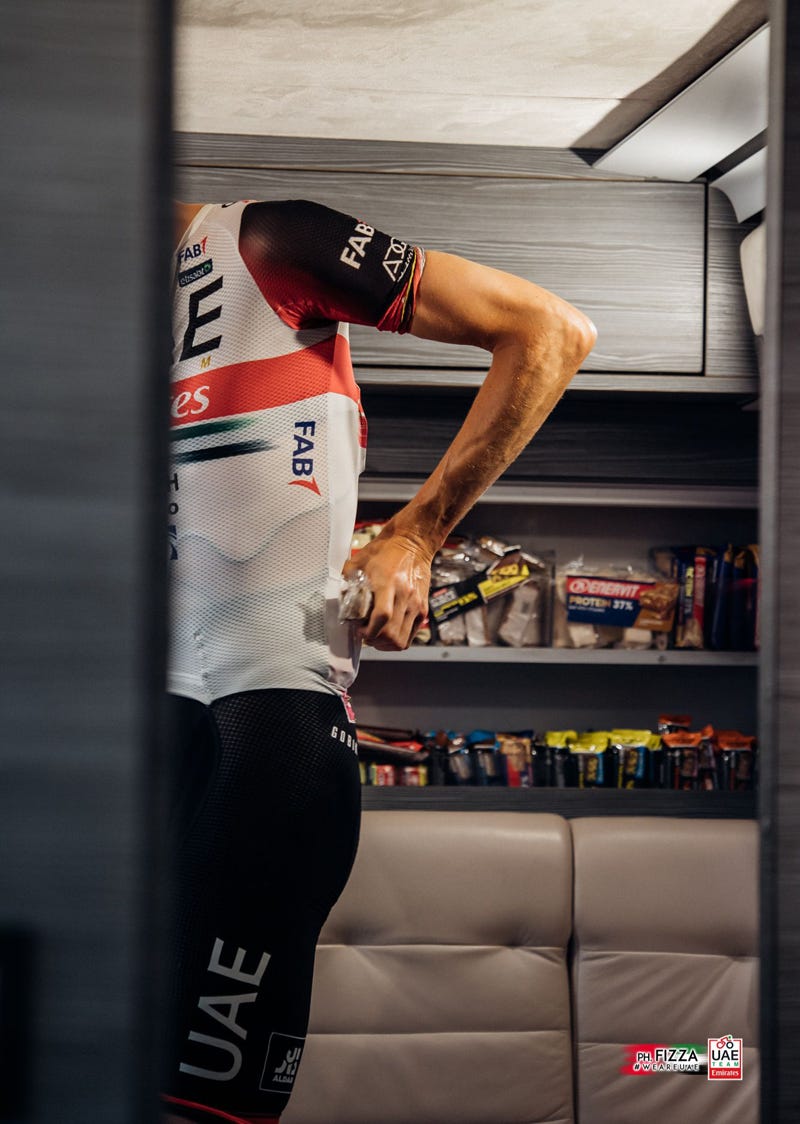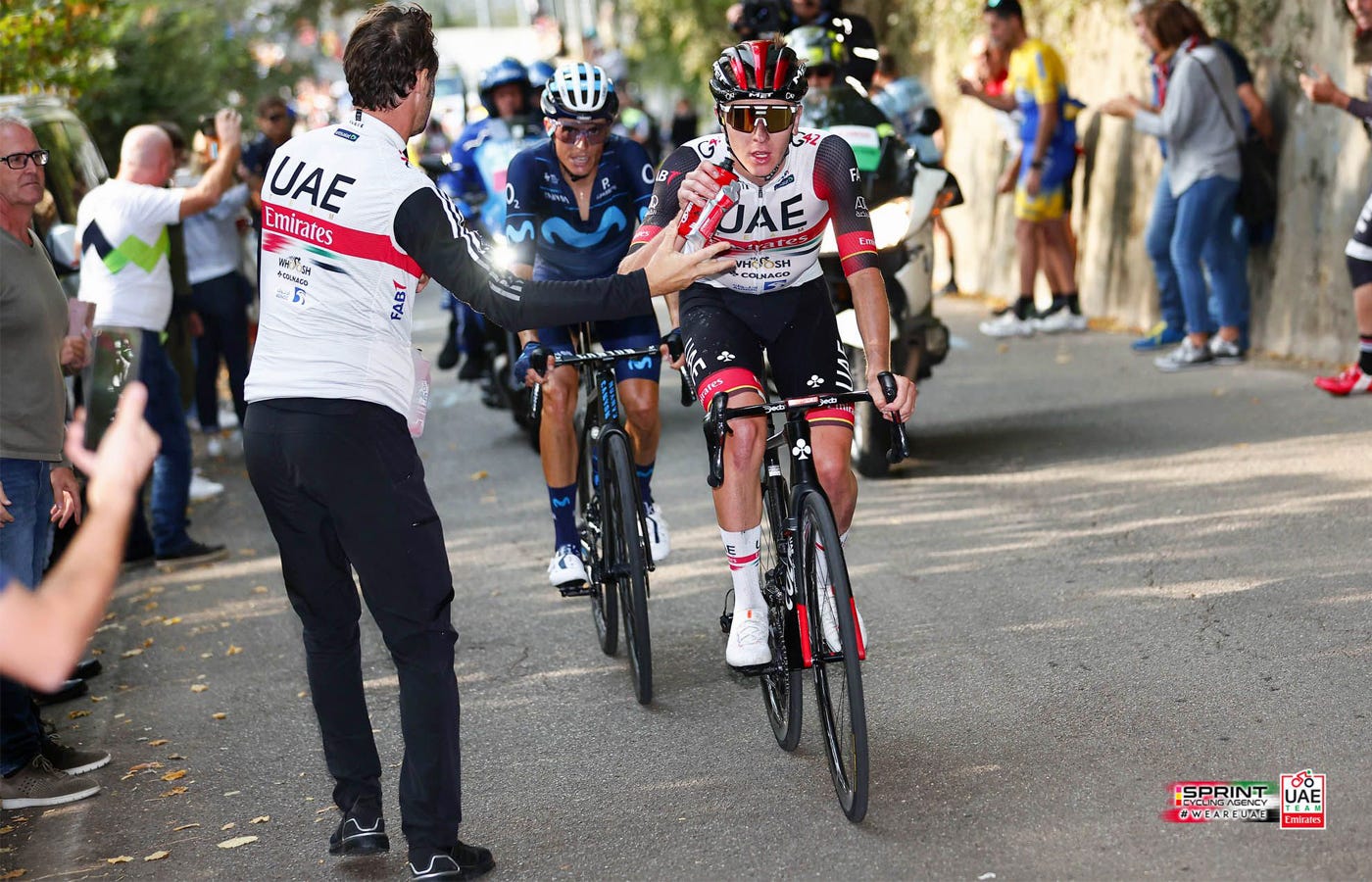The Nutrition of the Pros
A behind-the-scenes look at UAE Team Emirates with Gorka Prieto!
by Equipe Enervit
Race conditions vary wildly, from sweltering heat to mountain chill, and include hours in the saddle each day. A racer’s energy expenditure can range from 2000 to 6000 calories per day, depending on the stage profile: flat or mountain. Behind every WorldTour racer competing in a grand stage race, from the nutritionist to the dietician, from the athletic trainer to the chef, there’s a team of professionals working alongside him. Cycling today has changed from years past and, along with equipment, nutritional strategy has also evolved…before, during, and after each race.
How does a pro feed himself?
We discuss this with Gorka Prieto-Bellver, nutritionist for UAE Team Emirates, who told us how the nutritional strategy for a WorldTour professional is key to sustaining significant energy expenditure, and to promoting proper recovery.
When did you start working as a sports nutritionist?
"I started ten years ago, right after graduating. Following my first experience with a football team, my real professional debut was with a continental team in the Basque Country, where I’m from and where cycling is very popular. From there I landed in the WorldTour, with UAE Team Emirates.."

Nutrition is fundamental in cycling; more and more teams are structured to include dedicated professionals. Tell us about your typical day!
"Let's say I have two 'typical days':
- when I'm at home and have to prepare the nutrition plan for the team, whose members compete simultaneously in different parts of the world;
- when I'm at a grand tour.
In any case, I have daily correspondence with each rider. I monitor his or her weight and fitness, and I constantly talk to the athletic trainers to see if there are any relevant aspects to take into account, so that I can design the right nutritional plan for that moment.
For some years now we’ve been communicating with athletes in real time via a dedicated online coaching app, which allows us to follow the athlete on a daily basis and upload the training plan for him or her. The nutritional plan for training varies from week to week, and I design it according to the target goal: lose weight, remain stable or train the stomach. During competition, I send all information to the team chefs who make changes according to the stage.
Everything is calibrated, starting with breakfast. We know the carbohydrate, protein and fat content of each recipe. Working directly with the team chefs, I can always gather feedback from the athletes to share with the chefs."
Do riders request substitutions of one food for another?
"Yes, sometimes it happens, and we always try to please everyone. We provide different types of carbohydrates and proteins at mealtimes. I identify the target goals, and the chefs operate within the goals’ perimeters, taking into account the athletes’ tastes.."
Is it true that racers also eat at the finish?
"Affirmative. Together with the chefs we prepare solid food to take on the bus for the post-race period. Before the race, however, it depends on the weather conditions — if the temperature is high, we try to avoid any food in solid form."
Does breakfast vary according to the stage?
"Yes, based on the nutritional charts and the forecast, we tell each racer how to manage themselves. Race conditions can have a big influence, but we also try to satisfy the palate. These days a racer can choose between porridge, pancakes and bread for breakfast; the days of white rice dominance that racers were accustomed to 15 years ago are over."
You recently recommended eating an energy bar with a good protein quota just before the start of a race. Can you explain why?
"We have to take into account that breakfast takes place a few hours before the start. As we get closer to the start, we need to supplement our protein intake to achieve 2g per kg, which is the ideal quota to avoid losing muscle tone during the race. A high quantity is not required, nor is it needed for performance (there are carbohydrates for that, ed), just a snack source of protein."
Are there differences in supplementation plans for a stage race compared to a one-day road race?
"It's not so much the type of race that makes the difference as it is the route. Lots of climbing involves a completely different energy expenditure from a predominantly flat race. During a flat race the energy 'savings' can be up to 30 percent, so you eat less. Let's say that the integration solutions are the same. The post-race strategy changes. In a stage race and especially in grand tours, the objective is to get the rider to recover as quickly as possible for the next stage. An important factor is weight. That's why we always have to be very precise."

How do the pros remember what and how much to eat in the race? By radio intel? By memory or other “tricks”?
"They know it by heart, they are vigilant and precise with their timing. They’re aware that — if they don't integrate — they can run into crisis. But if a distraction happens, the DS will remind them.."
How often do they feed in the race?
"From the start, every 15 minutes. The guys know that they have to take the set quota of carbohydrates per hour. In addition, along the race sections there are soigneurs with musettes, and you can always count on the team cars for refuelling during the race."
Does supplementation during racing change as temperatures rise?
"A lot. Both in terms of the liquids taken every hour, and in terms of lost sodium that needs to be replenished. Oftentimes, in the heat, many riders look 'whitewashed' by the end of the stage because they are covered in salt crystals. In this case, more sodium needs to be replenished. On a hot day you need more water bottles than when it’s cold. The amount of carbohydrates to be taken, however, always depends on the route profile. Once established, only the formulation varies, for instance powder that’s dissolved in a water bottle or gels or bars.
We use 1 bottle with Isocarb C2:1PRO and 1 bottle of salts, to be selected as required. When you lose more than 2 percent of your body weight during a race, your performance suffers. That's why it's important to take isotonic drinks rich in mineral salts — they reduce the risk of cramping and promote proper rehydration."
Having "enjoyed" the new C2:1PRO line since the first tests, what feedback can you give us today, after months of use in competition?
"Everyone likes the new products; the Carbo Jelly in particular is really good. As a nutritionist, I can say that the new line helps us a lot. The riders are really happy with it and like all the formulations, both in terms of taste and, above all, because they can easily intake high amounts of carbohydrates without any gastrointestinal discomfort."

What other products do the riders take, apart from the classic carbohydrates and proteins in their different formulations?
"Omega-3 every day, magnesium, iron, multivitamins and lots of salts."
What’s eaten between races to recover without affecting performance?
"When we talk about nutrition in cycling, we must understand that it all starts with the post-race recovery phase. Our recovery is based on a 3:1 ratio of carbohydrates to protein. When translated into food, that ratio becomes a dinner that everyone likes: rice, pasta, burritos and even sushi!"
Let's dispel a myth: beer after a stage win?
"Never! (smiles, ed.) Someone who likes to drink beer invented that myth! No swigs until the end of the Grand Tour! Only afterwards are you allowed some freedom."
When you win three big races in a short timeframe, as happened with Pogačar, is there a greater energy expenditure?
"It always depends on the rider’s weight. It's not about 'how much you win' but about the energy spent. Watts, weight, type of stage and feedback from the athlete are the parameters on which to build a nutrition plan. We’re talking about a human body, not a robot. Continuous dialogue with the athlete is very important. I can make a theoretical estimate of consumption, but then we calibrate it according to what happens day after day in the race."
And what does Tadej like most?
"A bit of everything, but he particularly likes burgers with baked potatoes. Tadej eats 400g of potatoes with some bread or rice. Also, he really likes the Crunchy Caramel bar that he always takes before leaving. The important thing is to calibrate what you eat according to your effort. Varying the menu helps with the mental aspect of racing. Only one percent of racers choose white rice and omelettes every day, and those are personal choices."
You often talk about "precision". Are there any UAE racers who are as precise as you?
"Yes, more than one! Rafal, Wellens and Soler, to name a few. In general, the whole team is really attentive to nutrition. Nowadays you can enter the pro ranks when you’re barely 20 years old. Young people at this age are very careful with respect to nutrition. Overall performance is the result of many things, including attention to detail."
To what extent can amateurs be inspired by the strategies of the pros?
"The most common mistake amateurs make is not eating when they train. They want to be thin and think they can ride three or more hours without eating anything. Or at most, a gel. To really improve, take care of your recovery and don’t arrive home too hungry, you have to be precise. My advice is to train your intestine to absorb the amount of carbohydrates per hour required for your activity level. The benefits will be unquestionable."





